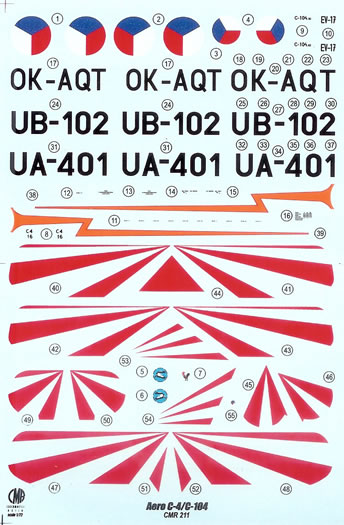|
Aero C-4 & C-104

Czech Master Resin, 1/72 scale
S u m m a r y : |
Catalogue Number: |
Czech Master Resin (CMR) Kit No. 211 - Aero C-4 & C-104 |
Scale: |
1/72 |
Contents & Media |
29 x cream resin airframe parts, 9 x pale tan resin struts & braces, 2 x clear resin windscreens, I x acetate sheet with 2 x windscreen outlines, 1 x coloured Eduard photo-etch of 24 parts, and decals for 4 subjects |
Price: |
Available online from Hannants for £24.70 and various other CMR stockists. |
Review Type: |
First Look |
Advantages: |
Nicely detailed and comprehensive kit. |
Disadvantages: |
None apparent |
Conclusions: |
A neat addition for builders of 1930’s & 40’s light aircraft. The only slight challenge will be its biplane construction. |
Reviewed
by Mark Davies

HyperScale is proudly supported by Squadron.com
In the early 1930’s the newly founded Luftwaffe had a need for large numbers of trainers in three engine power ranges: 240-hp, 150-hp and 80-hp. The last category was met by the Bu 131 produced by the newly formed Bucker company (Its founder, Carl Bucker, had returned from Sweden where he had been Managing Director of Svenska Aero AB following his WW1 service as a pilot in the German Naval Air service).
The 80-hp design had to be economical to produce and operate, sturdy, and suitable for primary training and introduction to aerobatics. As such it had above average manoeuvrability. An international appreciation of its characteristics led to licence production by Czechoslovakia as the Tatra T-131, as well as by Switzerland, Spain, Hungary, and Japan under other designations.
The T-131 was an unsuccessful private venture attempt pre-1938 to sell the Czechoslovak Air Force a primary trainer. Later, under German domination, the Czech Aero company was to produce Bu 131’s for the Nazi war effort, along with many other German designs. Post-war the Czechoslovaks put 12 Bu 131’s back into service, and then decided to adopt the design as their primary trainer, but with a more powerful 105-hp Walter Minor 4-III engine. This version was known as the Aero C-104, and some 260 examples were produced.
This is a new tooling of the Aero C-4 & C-104 by CMR. It is packaged in a sturdy top-opening box with attractive box art. Similar kits have also been released by CMR at the same time, these being the German Bu 131 and the Japanese Kawasaki Ki 86 or Watanabe K9W.
The parts and decals are in heat sealed plastic bags, which in turn are sealed in a further bag with the instructions and colour scheme diagrams. Straightforward instructions consist of five A5 pages, whilst another A4 page provides a rigging diagram. The instructions also clearly illustrate the differences applicable to the C-4 and C-104 versions offered by the kit (different fuselages, cowl fronts, propellers and instrument panels). Easily overlooked, is a small square of paper with a photo of a covered front cockpit that can be used on two of the subjects covered by the decals. However, this will need to be scratch-built. There are four A4 pages of 4-view painting & marking guides with colour call-outs in generic colours, three of which are very striking schemes. Finally there are four A4 pages of in-service C-4’s and C-104’s.
The parts breakdown is completely conventional for a small biplane, although a nice touch is the one-piece fuselage that receives the cockpit from its underside. Casting blocks will be easily removed, as will the very thin flash that is present in places. The wing struts and the undercarriage are cast in a pale tan resin. This resin obviously has better load-bearing properties than the cream resin used for the remainder of the kit.
Some will appreciate the clear resin windscreens over the more usual CMR vac-from clear parts. There is an alternative flat acetate sheet with two windscreen outlines. These will need to be carefully cut out and folded if chosen in preference to the clear resin options. Personally I’m happy with either medium.
The Eduard-sourced pre-coloured PE fret supplies instrument panels and seat belts, throttles etc to dress up the small open cockpits nicely. There are six instrument panels to cater for the Bu 131 and C-4/C104 boxings offered by CMR, but as these are numbered on the fret it’s easy to identify the correct two to use from the instructions.

Decals are typical of CMR, being well registered and suggest good opacity. Based on past experience they should be very good to use; but like most Czech decals they will be quite thin and need to be floated into position, as they tend to adhere extremely well once there is no fluid under them.

The subjects covered are two options each for the C-4 and C-104. Three of these feature quite vivid high-visibility markings on the wings.
This is a superbly executed kit of an interesting subject. Being a small biplane it may be a little fiddly to build, but well worth the effort. I highly recommended it.
Thanks to Czech Master Resin for this review sample.
CMR Models are available
online from Hannants in the UK,
Red Roo Models in Australia
and
quality specialist model retailers worldwide.
Text Copyright © 2009 by Mark Davies
This Page Created on 15 October, 2009
Last updated
15 October, 2009
Back to HyperScale
Main Page
Back to Reviews
Page
 |
